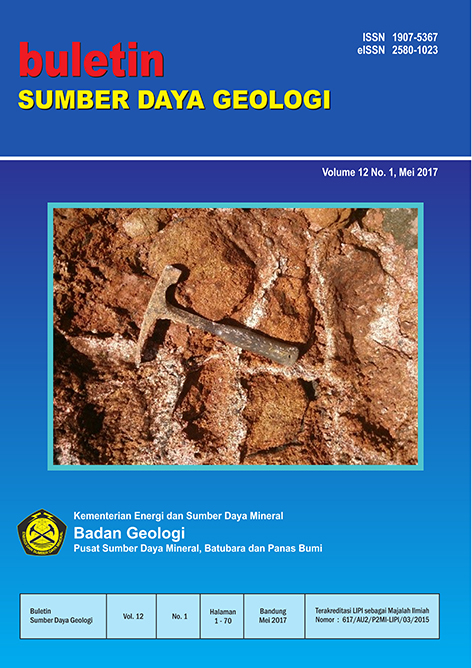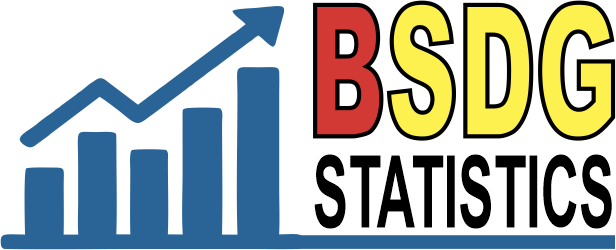CEBAKAN NIKEL LATERIT DI PULAU GAG, KABUPATEN RAJA AMPAT, PROVINSI PAPUA BARAT
Abstract
Pulau Gag, yang terletak terpencil di deretan kepulauan Raja Ampat, merupakan pulau yang memendam sumberdaya mineral yang berlimpah. Sumber daya tersebut berupa cebakan bijih nikel laterit (Ni, Co, Fe) yang menempati ± 2/3 dari pulau tersebut. Secara geologi, 2/3 bagian Pulau Gag ditempati oleh komplek ofiolit yang terdiri atas batuan ultramafik (serpentinit, harzburgit, dan piroksenit) sedangkan sisanya ditempati oleh batuan gunungapi. Komplek ofiolit di Pulau Gag ini diduga sebagai kerak samudera yang secara tektonik tersungkup di tepi benua dan busur kepulauan akibat adanya pergerakan Benua Australia kearah utara. Laterit nikel terbentuk akibat adanya proses pelapukan kimia yang terjadi pada batuan ofiolit yang telah mengandung nikel. Bijih nikel sekunder berupa garnierite diendapkan kembali dalam horizon tanah penutup, limonit dan saprolit setelah mengalami pengayaan oleh proses pelapukan. Berdasarkan hasil analisa contoh, menunjukkan bahwa kandungan Ni dalam laterit adalah 1,2% Ni, >30% Fe (lapisan limonit); 1,2% Ni, <15% Fe (lapisan saprolit).
Downloads
References
Abidin, H.Z., Wahyono, Ari, K. dan Amir, H., 2012. Eksplorasi nikel laterit di Pulau
Waigeo, Papua Barat. Laporan Perusahaan. Tidak terbit.
Abidin. H.Z. dan Rahman, 2011. Eksplorasi nikel laterit di daerah Baula, Kolaka,
Sulawesi Tenggara. Laporan Perusahaan. Tidak terbit.
Abidin, H.Z. dan Baharuddin, 2007. Eksplorasi nikel laterit di daerah Maba,
Halmahera Timur, Maluku Utara. Laporan PT. KSM. Tidak terbit.
Abidin H.Z., Baharuddin dan Partoyo, E., 2007. Eksplorasi nikel laterit di daerah Buli,
Haltim. Laporan PT.KSM. Tidak terbit.
Abidin, H.Z. dan Rusmana, E., 2003. Origin of iron oxide within weathered granite and tin alluvial deposition, South Bangka District, Bangka-Belitung. Majalah Geologi Indonesia, 18 (2), 95-105.
Abidin, H.Z., 2001. Iron oxide associated with the ultramaphic rocks, Mt. Kukusan Area,
South Kalimantan. Indonesian Mining Journal, 7 (3) : 14-23.
Abidin, H.Z. dan Hakim, AS., 2001. Dismembered ophiolite Complex in Mt. Kukusan
Area, Batuicin District, South Kalimantan : Synthetic, origin and
economic important. Publikasi Khusus, Puslitbang Geologi, 28 : 75-88.
Edward, P. dan Atkinson, K (1986), Ore Deposit Geology, Chapman and Hill, London-
Newyork, halaman 18-37.
Evan, A.M. (1992), Ore Geology and Industrial Minerals : An Introduction, Blackwell Scientific Publication, 390 h. Geoscience and Natural Resources, Germany, 1982.
Hamilton, W. (1979), Tectonic of the Indonesia Region, Geol.Survey Prof. Paper 1078, 345h
Kertapati, E., Asdani, I. Effendi (2001), Peta Kegempaan Indonesia, Pusat Penelitian dan Pengembangan Geologi, Bandung.
Nicholas, A. (1989). Structures of ophiolites and dynamics of oceanic lithosphere. Kluer Academic Publishers. Dordrecht-Boston-London. 311h.
Pieters, P., C.J. Pigram, D.S. Trail, D.B. Dow (1983), The Stratigraphy of Western Irian Jaya, Bull. Geol. Res. and Dev. Centre, No.8 14-48
PT. Antam – BHP Minerals (1999), Gag Island Joint Ventures Progress Report #1 Tidak terbit.
Supriatna, S., Hakim A.S. dan Apandi, T. (1995), Peta Geologi Lembar Waigeo, Irian Jaya, Pusat Penelitian dan Pengembangan Geologi, Bandung
Wilson, M. (1989), Igneous Petrogenesis, Unwin Hyman, London, 466 h.
Copyright (c) 2017 Buletin Sumber Daya Geologi

This work is licensed under a Creative Commons Attribution-NonCommercial-ShareAlike 4.0 International License.
Authors whose manuscripts are published agree to the following terms:
The publication rights of all journal manuscript materials published on the Buletin Sumber Daya Geologi website are held by the editorial board with the knowledge of the author (moral rights remain with the manuscript’s author).
The formal legal provisions for access to digital articles in this electronic journal are subject to the terms of the Creative Commons Attribution-ShareAlike (CC BY-SA) license. This means that Buletin Sumber Daya Geologi has the right to store, convert media/formats, manage in the form of a database, maintain, and publish the article without requesting permission from the author, as long as the author’s name is cited as the copyright holder.
Manuscripts published in both print and electronic formats are open access for educational, research, investigative, and library purposes. Beyond these purposes, the editorial board is not responsible for any violations of copyright law.















